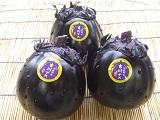Yoshikawa Nasu
| Registration Number | 14 |
|---|---|
| Name of the GI | Yoshikawa Nasu |
| Class | Vegetables/ Cereal grains/Pulses |
| Date of Protection | 2016/07/12 |
| Producing Area |
Fukui Prefecture
Sabae City,in Fukui Prefecture |
| Applicant - Name and Address | Sabae City Traditional Vegetable Cultivation Study Group 13-1 Nishiyama-cho, Sabae City, Fukui Prefecture (Agricultural Public Company Green Sabae: in Sabae City Hall Agriculture and Forestry Policy Division) |
| Brand-site | https://www.city.sabae.fukui.jp/oishii/oishii_nakama/oishi-yoshikawanasu.html |
Yoshikawa Nasu is a round eggplant that has a firm flesh quality and is shaped like an oval or money-bag (Japanese purse from olden times). It is grown around the former Yoshikawa Village of Sabae City. It has a strong taste and a unique shape reminiscent of a softball with a diameter of about 10cm and weight of about 300g; and is used in Japanese restaurants and high-class restaurants inside and outside the city. Nowadays, house cultivation is mainstream because its outer skin is thin and the vegetables are easily scratched. Also, the rich amount of moisture produces the thickness when cooked. The vegetables are blackish-purple and glossy, and have sharp thorns in the calyx.
On the market, its stable quality and quantity due to the commitment of well-organized, skilled farmers are highly appreciated, and strict quality inspection is carried out regarding shipping. Also, many chefs praise the facts that the seeds are small, and it does not fall apart while cooking.
The main point in its cultivation is to allow only 3 or 4 branches to grow, including the main branch, so that each branch has sufficient strength and vigor to sustain larger eggplants. The main harvest time is June to November. The annual harvest yield is about 40 from each tree, which is less than half compared to the high-yield type eggplant.
Only eggplants with black-purplish color, good gloss, no damage, deformation or sunburn are selected, and each one of them is shipped in a fruit mesh to prevent damage from the thorns in the calyx.
The former Yoshikawa Village of Sabae city is a fertile land where sediment accumulates due to flooding of the tributary of the Hino River, the Tenno River. It is blessed with fertile soil in the Sabatake Basin which is suitable for cultivation of eggplant and moderate rainfall throughout the year.
Production of Yoshikawa Nasu had peaked mainly in the former Yoshikawa Village around 1942 to 1943, but it gradually decreased with the emergence of improved, high-yield breeding varieties, and when the only production farmer passed away in 2009, production almost ceased. But the variety Yoshikawa nasu has been protected by volunteer farmers who received seeds. Today, traditional vegetable research groups have been organized, and they produce and ship about 45,000 eggplants yearly as of 2022.


